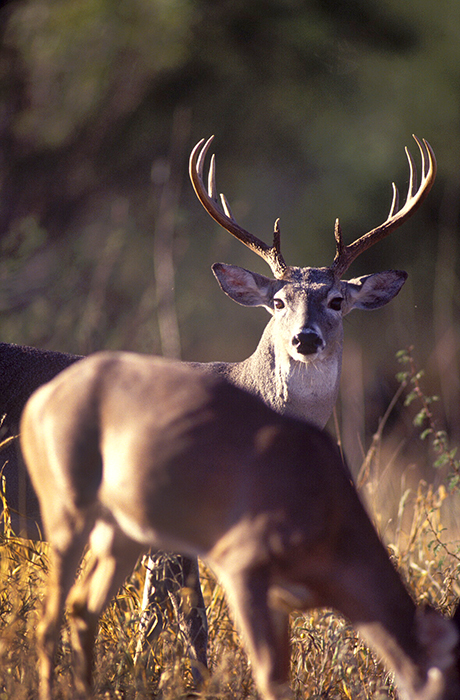
THIS BUCK LOOKS TO BE “tending” his mate. They may stay together for up to 24 hours – mating several times. The full study can be seen by googling “The Rut in White-tailed Deer,” authored by four respected wildlife biologists. The National Deer Association article on “Why Bucks “Vanish” When They Are Tending Does” by Lindsey Thomas, Jr, can also be googled. (Photo by John Jefferson)
By John Jefferson
Don’t be misled by the title. This is about wild deer breeding – NOT deer breeding facilities where CWD has been confirmed.
When my career began at TPWD as hunting and fishing regulations coordinator, I had hunted for years and written a book on deer hunting. But I had a lot to learn and asked a lot of questions.
One of the first was about deer breeding and how deer went about it. I was surprised that the TPWD Big Game Program Leader had never observed it. Since then, I’ve seen lots of bucks trailing does and some “tending does” that were hanging close to does that they either had just bred and/or intended to breed again.
Actual breeding takes place over about 24-hours when the doe is receptive. Most hunters have never witnessed it, either.
More on that further down, but WHEN the Rut – as the breeding period is usually called – takes place is more frequently discussed, so I’ll start there.
TPWD conducted an extensive three-year study throughout Texas – the largest deer study ever (2,436 does), and in the state with the most deer and deer hunters in America. They then counted back two hundred days – the accepted time lapse from conception to birth in whitetails – to determine the date of conception. Why?
Because bucks are most active during the rut — moving more seeking companionship and are more likely to be seen by hunters then.
The study plotted the peak of the rut – the date that the MOST deer were bred. Is that the best time to hunt?
Maybe. But plenty of deer fall before and after the peak date. Peak of the rut may be the best time to hunt, but it is far from being the only time. Deer can be killed throughout the rut.
Does unbred after the first rut will probably be bred during a later estrous period.
Hunters seeing this often think the rut is late. I once watched a buck “tending” a doe the first week of January.
Below are dates of the rut in most regions according to the study.
Gulf Prairies and Marshes Total Breeding period: Aug. 24-Nov. 30; Peaks: Northern Area Sept. 30; Southern Area Oct. 31. This is the earlies rut in Texas.
Post Oak Savannah Total Breeding: Sept. 30-Jan. 16; Peaks: Central, Nov. 10; Southern, Nov. 11.
Pineywoods Total Breeding: Oct. 21-Jan 5; Peaks: North, Nov. 22; South, Nov.12.
Rolling Plains Total Breeding: Oct. 8-Dec. 30; Peaks: North, Dec. 3; South, Nov.20.
Edwards Plateau Total Breeding: Oct. 9-Jan 30; Peaks: East, Nov. 7; Central, Nov.24; West, Dec. 5.
Cross Timbers Total Breeding: Oct. 13-Dec.17; Peaks: North, Nov. 15; South, Nov. 17.
Trans-Pecos Total Breeding: Nov.4-Jan.4; Peak: Dec. 8. (Drought the last two years of the study)
South Texas Plains Total Breeding: Nov.9- Feb.1; Peaks: East, Dec. 16; West, Dec. 24.
Regarding humans seeing deer actually breeding, most deer seek thick brush away from other bucks and human eyes, according to the few rare observations.
JJ




